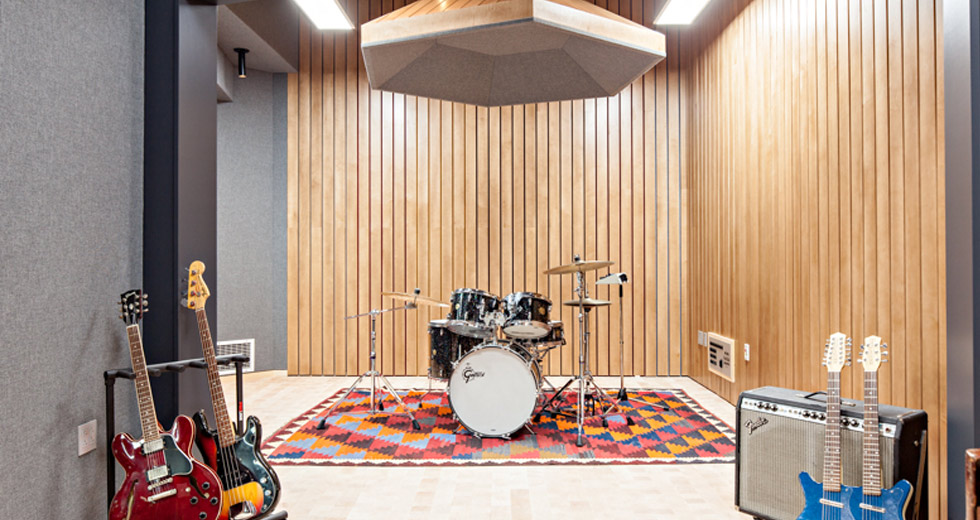Nightclubbing: SqueezeBox!
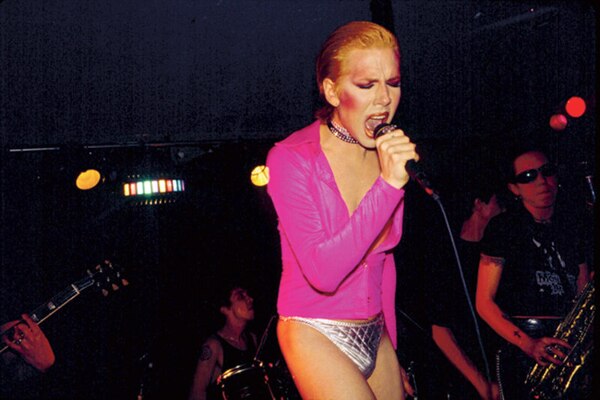
The year was 1994. Rudy Giuliani had just been elected mayor of New York. It was before the city was gripped by terror, before Times Square was recast as a Disneyfied playground for tourists, before models and bottles infiltrated, soured and sterilized its clubs.
After four years of Mayor David Dinkins’ meager one-term run, New York City still had its gritty and dangerous parts, with many pockets of Manhattan not yet gentrified to the teeth. Williamsburg was a Polish/Hispanic/Hasidic neighborhood; “hipster” was not a pejorative description for every kid from New Jersey wearing tight black jeans; and the Meatpacking District still had actual meat-packers. And the gay club scene, though not yet as iconic as in its ’80s heyday, was starting to coalesce into something that could claim a spot in New York’s rich nightlife history. As techno became de rigueur in Brooklyn warehouses, muscle queens danced all night in big Chelsea superclubs, and Michael Alig led club kids on dystopian drug binges at Limelight, another music subculture emerged downtown in Tribeca, on the far edges of the west side of Manhattan at a tiny, divey rock club called Don Hill’s.
Bored with the options for gay men and women, rock ’n’ roll fashion designer Michael Schmidt teamed up with Pat Briggs of the industrial band Psychotica, drag queen Misstress Formika and DJ Miss Guy to create SqueezeBox!, one of New York City’s last great parties.
SqueezeBox! gave gay (and straight) revelers a different kind of outlet. Every Friday, pretty boys, glam girls, rough rockers and cool celebs converged upon Don Hill’s, wearing their dirty, filthy, punk-rock best. The party birthed bands, revolutionized the drag scene and served as a hothouse for Hedwig and the Angry Inch, which went on to become an off-Broadway hit and a big Hollywood movie. The darkest days of the AIDS epidemic had passed, but the gay community remained on edge, remembering lost friends at the mercy of the caustic and careless mayor Edward Koch. They didn’t have a friend in Rudolph Giuliani, either, who upon taking office instituted a veritable war against nightlife, wielding an early-century cabaret law to close clubs down at will.
But SqueezeBox! survived. And long after it ended, the club’s influence was clear not only in quintessential pansexual New York parties like Motherfucker, Misshapes and Berliniamsburg, but in the rock revival and electroclash movements that would soon rule over Manhattan and Brooklyn. This is the story of SqueezeBox!.
Every Friday, pretty boys, glam girls, rough rockers and cool celebs converged upon Don Hill’s, wearing their dirty, filthy, punk-rock best.
Michael Schmidt (co-promoter of SqueezeBox!)
In 1994 I had a friend named Patrick Briggs, who had been a friend of mine for ten years and was managing a bar called Don Hill’s, a rock ’n’ roll bar. He called me up one day. I make clothing for entertainers – I didn’t really do clubs at that time, and I had never done a club before. He said, “We’re running this club and we want to do a gay night. Would you be interested in maybe putting something together and promoting it?” I said no. It wasn’t really on my radar of things I would conceivably want to do, but after thinking about it for a while, I thought that would be an opportunity to create the very club we all complained didn’t exist.
Michael T (DJ and co-promoter of the club night Motherfucker)
With me and with certain gay people that are similar to me, you’re sort of in this purgatory state where you go to a lot of straight clubs. Sometimes I’ll go to gay clubs and have a good time. But there’d definitely be something missing from gay clubs. All you would hear is house music, all you would see is Chelsea boys, all you would see is the typical drag number, which could sometimes be phenomenal and other times be whatever. It was bland. It was something that I didn’t fully connect with, nor did I want to.
Larry Tee (DJ, founder of the club night Berliniamsburg and creator of the Electroclash Festival)
SqueezeBox! was for those who did not feel comfortable in the Sound Factory or Roxy. It really was the alternative to that big room, cha cha, tribal nonsense, brain-numbing, washing-machine stuff at the end of the ’90s. SqueezeBox! was the perfect antidote.
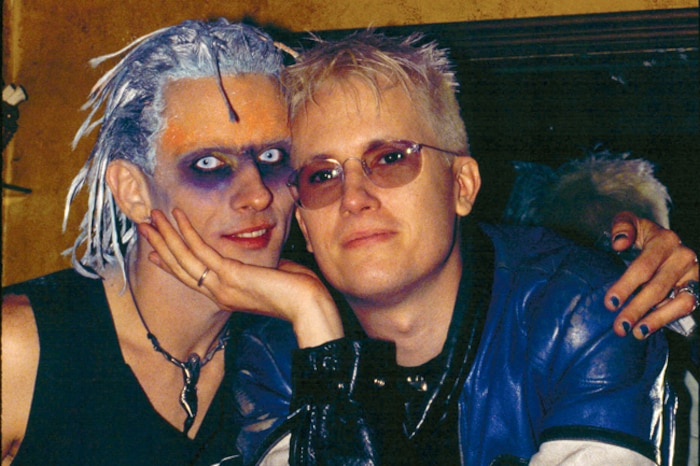
Michael Schmidt
There had been a club in the late ’80s called Rock and Roll Fag Bar, run by my friend Dean Johnson, which was amazing and great and much needed and fairly short-lived. It was incredibly fun, although they didn’t have live bands. No gay clubs ever had live bands. I was sick of seeing drag queens lip-synching. So I thought, “What if we put a rock ’n’ roll band, a punk band together, and we have queens singing? That’ll be the show.”
DJ Miss Guy (SqueezeBox! resident and singer of the Toilet Boys)
Michael asked me who I thought should be the drag MC and my two choices were either [Lady] Bunny or Misstress Formika. I didn’t know Formika well at that point but I’d seen him around and we’d met a few times and I thought he was great and funny as hell and I loved him.
Michael Schmidt
As soon as I saw [Formika] perform, I said, “This is the one, this is a star.” So I asked her if she would be the hostess and she could sing with a band every week. Well, she had never sung before.
Misstress Formika (drag performer and host of SqueezeBox!)
I said that I’m not a trained singer and to be honest with you I’ve only sang twice in my life and that was in high school for school plays. But I’m willing to give it a shot.
DJ Miss Guy
Formika was... If he wasn’t feeling confident, he was faking it and no one would have ever known. He was an automatic star. He’s one of the best.
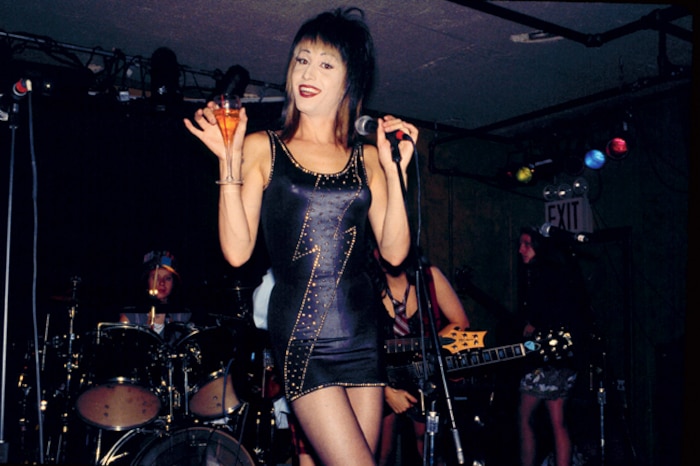
Michael Schmidt
[Opening night] was on April 15 of 1994. It was really scary. Because you don’t know how all of those things are going to be responded to. You don’t know if people are going to show up. But we had the Lunachicks play. All the elements were in place. I knew it could work, but you don’t ever know if people are going to pick up on your vision or not. So you kinda lay it out there and see. And people went wild.
Thomas Onorato (doorman for SqueezeBox!, Misshapes and Motherfucker)
You couldn’t lip-synch, you had to perform with a live band – which at the time [was] revolutionary.
Michael Schmidt
We had all the best drag queens in town, they all performed with the band.
We had all the best drag queens in town.
Misstress Formika
The first year it was really difficult to get queens to come and sing. I had Lina there and Candis [Cayne] there – all these people that don’t really sing. I would convince them and say, “No, you can do it. If I can do it, you can do it.” They would come in and they would turn it out, you know? I would sit there all day from like three in the afternoon till seven or eight at night the day of the show. I would listen to the queens and talk to the bands and say, “They can’t sing it that fast, slow it down.” We would take punk songs and make them into ballads; we would take ballads and make them into punk songs. However we needed to re-orchestrate the songs so the queens sounded good, that’s how we did the songs.
Michael T
It brought drag to a different area than before. We had drag that was not necessarily pretty, and drag that was singing live and singing rock with live musicians, and drag that was being performed to a mixed audience and not just a gay male audience. In that sense it gave a lot of performers – legendary people like Joey Arias, Sherry Vine – a platform.
Misstress Formika
The queens in New York were definitely ruling. We were ruling so much in New York for the drag scene that queens like Justin Bond and Jackie Beat moved here. Everybody wanted to be a New York drag queen.
Michael Schmidt
I put a whole sort of package together. Miss Guy, the DJ, was my roommate and he was one of the best DJs I knew. He had a very eclectic collection of music. He would go from old-school punk rock to a Brigitte Bardot song, or he would play The Cramps into Led Zeppelin and Buddy Holly – it just wasn’t done back then.
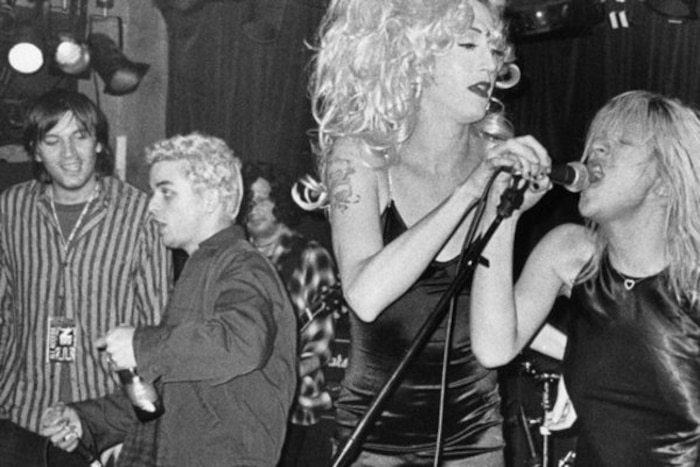
DJ Miss Guy
I’d only been DJing six months when we started SqueezeBox!. I used to play The Plasmatics and the place would be packed and going wild. I had never seen a party where that happened before or since. I really went all over the place and it worked. It was a time where there was no Internet really, and no digital music, so in those days you went to hear a DJ and you went to hear their collection. Now people can Shazam what the DJ is playing and buy it on their phone.
Misstress Formika
In my 20 years in nightlife, I always found that the best parties that last the longest and are the most legendary are those that start off with just a group of friends, and their friends, having a good time. A slow build is the way to go about that. Any party that starts off with a bang has nowhere to go but down. We had nowhere to go but up.
Michael T
They would open around 9 PM. They had a few opening bands, which led to a headliner, which then led to the late-night show. So it was kinda between the headliner and the late-night show when the dance version of the party would really begin to percolate.
Thomas Onorato
SqueezeBox! was one of the parties in the larger scene where people actually danced on the dancefloor. Where it wasn’t a mosh pit and it wasn’t people just hanging around waiting for a band.
DJ Miss Guy
I think after that you had gay bars in the East Village playing rock. More rock DJs coming around in that world, whereas before there really weren’t any.
There were gay people, and there were straight people, and then there were people you weren’t sure about.
Larry Tee
Motherfucker and SqueezeBox! were definitely kissing cousins because they shared a lot of the same talent. Misshapes was their gay grandson who did not want anything to do with them. They were more likely to be in Helmut Lang than Michael Schmidt.
Michael T
The two biggest influences for Motherfucker were SqueezeBox! and Green Door, which was happening around the same time. Green Door was the straight version of SqueezeBox!, but it was totally East Village, total rock ’n’ roll. It was definitely shooting for a Max’s Kansas City vibe. There were clearly gay people, and there were straight people and then there were people you weren’t sure about. And there was just that energy – a certain type of energy that’s created that cannot be pre-programmed or falsified.
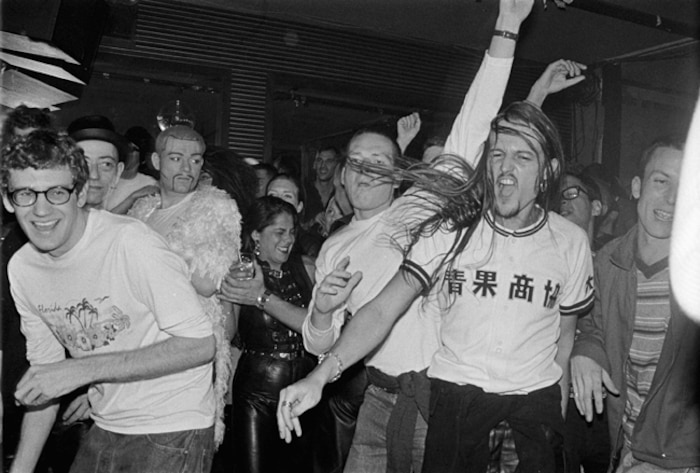
Jake Shears (lead singer of the Scissor Sisters)
[SqueezeBox!] had a wild mix of women, gay guys, people that were transgender, drag queens. It was a queer crowd. It wasn’t necessarily just a gay crowd. That’s the magic combination. If you can get all those people in a scene and in a whole world where everyone’s got a like-minded attitude and is not necessarily wholly gay, that’s something. Then you have a real party that actually means something, because it’s not just one thing or another. It’s actually more than just sexuality. It’s an attitude. It’s a philosophy.
Larry Tee
If it’s kind of gay, assholes don’t want to hang out there. It’s asshole repellent. Bottle service [types], they don’t want to hang out with some faggots.
Michael Schmidt
[At SqueezeBox!] we had a sign at the door that said “This is a gay rock ’n’ roll club, if you can’t handle us, fuck off.” So from the get-go it was made very clear to anybody that came that we were not going to put up with any bullshit from anybody.
Misstress Formika
We were always very outspoken. Misshapes was just an outfit party. They’re fun and great for what they are, but they had no substance. If things were going on in the city that were wrong, people at SqueezeBox! were informed. We had a few protests against Mayor Giuliani.
Michael Schmidt
SqueezeBox! is a response to really two things. The AIDS crisis had really taken all of the talent out of the city. It demolished the scene. It needed to be rebuilt from the ground up. And there was also the need to bring the straight and the gay communities back together because there was a lot of alienation there.
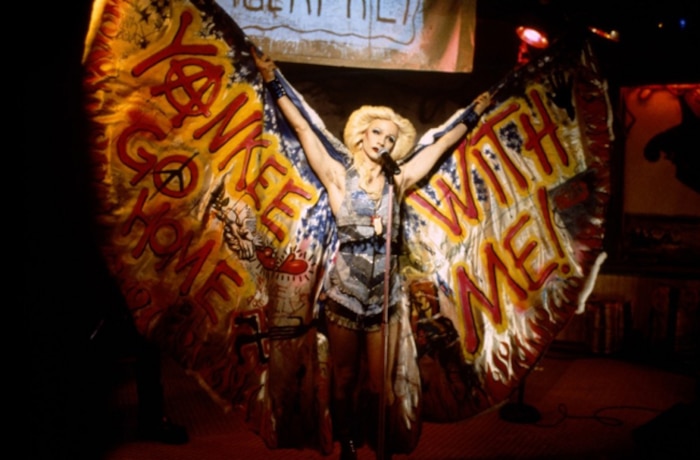
John Cameron Mitchell (creator of Hedwig and the Angry Inch)
It was the club that I had always been waiting for my whole life. I could just barely tolerate the music in most gay places until that point. But in terms of a full-on queer rock ’n’ roll place that was performance-based but also a place where, you know, you could slam with cute boys without fear of breaking their hair – that was the place to go. You know, it was kinda scary. You never knew what was gonna happen. It was like punk rock just got invented by gay people at that point. There was always The Buzzcocks and Jayne County and everything. So it was from heaven.
DJ Miss Guy
I remember John was hanging out there. We were introduced because he was good friends with the guitarist of the SqueezeBox! band, Stephen Trask.
Michael Schmidt
[John] asked me if he could perform a theater piece that he was workshopping with the band. I said, “Well, I guess so, but you have to know this is real life for these people. You have to show a great amount of respect to these queens who perform here on a regular basis. If you’re gonna work this out, make it real, make it your own.” And he did.
It was the club that I had always been waiting for my whole life.
John Cameron Mitchell
Very quickly Stephen Trask said, “You can practice being a fake rock star,” which I was writing about, “And do a gig here, but you have to do it in drag.” He said I couldn’t do male characters. I had to do what was originally a supporting character of Hedwig. Because it was really about Tommy the boyfriend, who was the son of the general, as I was. And then the supporting character was sort of thrust into the spotlight because it was a drag club and I had to do it in drag. So in a way SqueezeBox! forced Hedwig out of me like a toothpaste tube. It was just so scary. I had never sung in a band. I had never been in drag. So my first gig there was just, you know, full-on giving birth.
Misstress Formika
Oh, it was great. It went over really well, the first performance. I was like, “Wow, they love that.”
John Cameron Mitchell
You know, glitter, glitter, glitter.

Every time I went there I would see somebody like Blondie or Courtney Love.
Michael Schmidt
And then we started to get all kinds of crazy people coming in and wanting to perform. I had been friends for a long time, because of my work in entertainment, with a number of performers. Deborah Harry was a very big supporter of ours from the beginning. She performed with the band and with Misstress Formika. Nina Hagen came, and Lene Lovich came, Joan Jett, Marilyn Manson, all of those people would come and perform with the band. You just never knew what was going to happen.
Misstress Formika
At one point I’m downstairs with Courtney Love, the whole band from Green Day, we’re all drunk, and we’re all getting tattooed in the basement. I have a star tattoo on the bone on my hand and so does Billie from Green Day. Courtney didn’t get a tattoo that night, she just hung out with us and like 15 other people from SqueezeBox!. We all got tattooed at four in the morning.
Larry Tee
It was astounding because every time I went there, I would see somebody like Blondie or Courtney Love. It was definitely rock-star base for that time. It was like the place.
Michael T
You didn’t remember who was there because you were fucked up!
Larry Tee
If you wanted to do coke, you went to SqueezeBox!. If you wanted to do ketamine or ecstasy, you went to the Sound Factory.
Michael Schmidt
It started to snowball. You’d be standing there and you turn to your right and there would be Calvin Klein, you’d turn to your left and there’d be John F. Kennedy Jr., standing and talking to some drag queen or some little punk kid. It was amazing. It was an incredible mix of the high and the low. John Waters called it the greatest club in America.

Misstress Formika
So many things came out of it. The Toilet Boys came out of it, Hedwig came out of SqueezeBox! – it definitely started singing careers for a lot of the queens. Of course, Psychotica, Pat Briggs’ band, they had a big whirl from SqueezeBox!.
Michael Schmidt
It was nuts. The capacity was 150. It was really tiny – it was a hole in the wall. The bathrooms were horrible. It was a mess, but it was great. It was down and dirty and that’s what you wanted in a rock ’n’ roll bar. You don’t want something slick and polished with table service if you’re gonna cater to this kind of crowd. You want something real – and we gave it to ’em.
Misstress Formika
SqueezeBox! was, definitely, in my 20 years, the most decadent party that I’ve ever worked at.
DJ Miss Guy
I think that people realized that it was special. I certainly did.
A version of this article appeared in The Daily Note, a free daily newspaper distributed in New York during the 2013 Red Bull Music Academy.
